
a picture overlooking osaka at night. photo by Pixabay
When the Sun Sets, Osaka Truly Wakes Up
If you ask most tourists what they know about Osaka, they'll mention Universal Studios or maybe Osaka Castle. Ask me and I'll tell you that to understand Osaka, you have to experience it after dark. The truth is, you'll get a different side of Osaka City by the time nighttime rolls around.
![Busy Osaka at night]()
While Osaka Castle is magnificent during daylight hours, a stunning symbol of our city's history standing majestically among cherry trees, it takes on a completely different character after sunset when illuminated against the night sky.
As the sun dips below the horizon, traditional Japanese lanterns begin to light up the various Osaka Experiences throughout the city, casting warm pools of light onto the bustling streets. This transformation from day to night reveals Osaka's true character, one that can't be experienced through daytime sightseeing alone.
I've spent over three decades wandering these streets, from the packed izakayas of Tenma to the underground clubs in Amerikamura. The Japanese approach to evening entertainment is unique, but Osaka takes it to another level entirely. I've learned that nightlife isn't just an activity; it's the city's true heartbeat.

Friends ready for a night out in Osaka Photo by ANTONI SHKRABA Pexels
The Ritual of Beginning: Where Locals Start Their Night
We never plan too much. That's not the Osaka way. Instead, we follow our noses, sometimes, as the scent of grilling yakitori or sizzling kushikatsu pulls us down narrow alleyways most tourists would miss.

Laterns in Osaka
Tachinomi: The Standing Bars Where Nights Get Their Wings
Our first stop is usually a tachinomi (standing bar). These tiny establishments barely fit 15 people, but that's the point. When you're shoulder-to-shoulder with strangers, conversations start naturally.
My favorite is a hole-in-the-wall spot near Dotonbori called Yoidore Tenshi ("Drunken Angel"). It's run by Tanaka-san (no relation, though we joke about being cousins). He pours sake carefully while keeping up a steady stream of Osaka's famous manzai-style comedy banter.
The Economics of Standing Bars
These places aren't just charming; they're brilliant business models. Lower prices (most drinks under ¥500), faster turnover, and the standing posture encourage you to drink just enough to warm up before moving on. It's the perfect launchpad for a night of bar-hopping.
The unwritten rule is to stay for two or three drinks, then surrender your spot to the next group waiting outside. There's something beautiful about this efficiency; it's very Osakan.

A picture of Kushikatsu on a plate
From Kushikatsu to Conversations: Food as Social Glue
By 9 pm, you'll probably find us squeezed into a Kushikatsu Spot in Shinsekai. Skewers of deep-fried meats, vegetables, and fish arrive one after another, and the only pause in conversation is to dip them in the communal sauce.
The Shared Sauce Philosophy
There's something unmistakably Osakan about that shared sauce pot. It sums up how we do things here: we're all in it together, so don't mess it up for the next person. The same goes for our nightlife: enjoy yourself, but don't forget that you're a part of a community.

The entrance of an Izakaya.Image by href Pixabay
Hidden Izakayas: Behind the Sliding Doors
By 10 pm, we're ready for an izakaya, those magical places where time seems to stretch. My go-to is a third-floor spot in a creaky building near Shinsaibashi. You'd walk right past the entrance if you didn't know to look for the small paper lantern marking the stairs.
Inside, there are low tables, floor cushions, and a menu handwritten daily based on what looked good at the market. The mama-san who runs it remembers everyone's drink preference, even if you haven't visited in months.
This is where the real conversations happen, fueled by highballs and plates of sashimi. Politics, heartbreaks, job frustrations; it all comes out around hour two at an izakaya. The beautiful thing about Central Osaka is how these hidden gems are tucked between gleaming department stores and office buildings. The city’s blend of modern energy and traditional roots creates a rhythm that, compared to even Tokyo, feels uniquely its own.
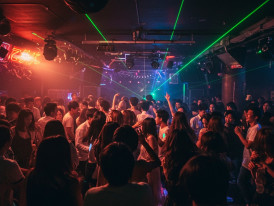
A picture of the dance scene at night.
Ame-mura: Where Osaka's Youth Culture Thrives
If you're under 30 (or just want to feel that way again), Amerika-mura (American Village) is where the night kicks into higher gear. This compact neighborhood is our answer to Tokyo's Harajuku, but with a distinctly Osakan twist.
During daylight hours, Ame-mura is a paradise for shopping enthusiasts. Vintage stores, streetwear boutiques, and quirky independent shops line the narrow streets. Shopping here is special because it blends international trends with Japanese culture.
By midnight, the vintage clothing shops have closed, but the clubs are just hitting their stride. Triangle Park; really just a small concrete area, becomes an outdoor gathering spot where fashionable youth display the day's purchases and decide which club deserves their attention.
Walking these streets at night, you'll notice how drastically different Ame-mura feels from other parts of Osaka city. While many areas balance tradition with modernity, this pocket of nightlife fully embraces contemporary Japanese youth culture, from fashion to music.
The Underground Beat of Osaka
Duck down nearly any staircase in Ame-mura and you'll find yourself in a basement venue pumping with music. From hip-hop at Club Joule to indie bands at Conpass, the deep beats of Southern Osaka's underground scene provide the soundtrack for this part of the night.
What separates these clubs from their Tokyo counterparts is the lack of pretension. Nobody cares what you're wearing or who you know; did you come to have fun? That's all that matters here. The clubs in this district embody Osaka's democratic approach to nightlife, where salarymen, students, and visitors can all find common ground on the dance floor.

Street vendor selling food
Dotonbori: The Neon River That Never Sleeps
When tourists imagine Osaka nightlife, they're usually picturing Dotonbori; that canal lined with massive animated signs, including the famous Glico Running Man. It's our Times Square, if Times Square were packed into narrow pedestrian streets and smelled much, much better.
Around 1 am, this area transforms from a tourist photo op to a playground for locals. The camera-wielding visitors retreat to their hotels, and we reclaim our territory.
Late-Night Street Food Rituals
This is prime time for our late-night food ritual. My group always gravitates to the same takoyaki stand; eight perfect balls of batter with octopus chunks, turned methodically by the vendor until golden brown.
We get them "atsui atsui" (piping hot), knowing full well we'll burn our tongues but unable to wait. There's something about standing in a circle of friends, each holding a small boat of takoyaki, laughing as we try not to scald ourselves, that epitomizes the Osaka experience.
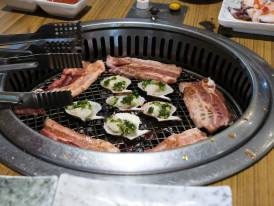
Ingredients on the grill Photo by href Unsplash
Okonomiyaki: The Midnight Flavor Bomb
If we're really hungry, we'll find ourselves at an okonomiyaki restaurant that stays open until 3 am. Unlike the Hiroshima style, Osaka's version mixes all ingredients together, a fitting metaphor for how we approach socializing.
Sitting around the hot grill, each person customizing their savory pancake, conversations flow as naturally as the Kewpie mayo and sweet sauce drizzled on top. It's impossible to maintain pretenses or stay strangers when you're all focused on not burning the same food.
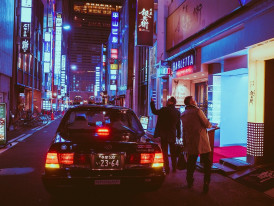
Picture of a comedy club.Masashi Wakui from Pixabay
Comedy Cellars: The Soul of Osaka's Entertainment
Osaka is Japan's comedy capital, and even at 2 am, you can find manzai (two-person comedy) performances in tiny basement venues. After a few drinks, even visitors who don't speak Japanese laugh along.
My favorite spot is a shoebox-sized place in Namba where comedians test new material. The audience sits on plastic crates, the stage is marked with tape on the floor, and the cover charge includes one drink of questionable origin. It's perfect.
Why Comedy Matters in Osaka
Osaka's comedy tradition dates back centuries and explains so much about our character. We value quick wit over politeness, humor over hierarchy. In a country often rigid with formality, Osaka carves out space for irreverence. This spirit infuses our entire approach to nightlife.

Picture of a karaoke night event photo by m-louis .® Creative Commons Attribution-Share Alike 2.0
Karaoke: Where Nobody Cares If You Can Sing
No night out in Osaka is complete without karaoke. By 3 am, vocal cords loosened by alcohol and inhibitions long abandoned, we pile into a private room at one of the 24-hour karaoke chains.
What happens in these neon-lit boxes stays there, which is probably for the best. I've seen strait-laced office workers transform into rock stars, confessions of unrequited love delivered via ballad, and friendship bonds cemented through terrible duets.
![Someone singing Karaoke]()
The Unspoken Karaoke Rules
There are rules to Osaka karaoke that visitors should know:
- Everyone must sing at least once
- No one may criticize another's performance
- Ballads after 4 am are asking for tears
- The person who chooses "Bohemian Rhapsody" buys the next round
These boxes become confessionals, concert venues, and occasionally, impromptu therapy sessions. I've solved more life problems in karaoke rooms than anywhere else.

A view of Umeda building skyline. Filename: umeda-nightview.jpg Photo by Kaiza96 Creative Commons Attribution-Share Alike 3.0
Umeda's Dawn: When the City Shows Its Gentle Side
For a change of pace around 4 am, we sometimes take a taxi to Umeda. The Umeda Sky Building observation deck officially closes much earlier, but there are night spots nearby that show a different side of the city. This massive dual-tower structure connected by a "Floating Garden Observatory" offers the most breathtaking panoramic views of Osaka city at night.
During the day, the Umeda Sky Building is packed with tourists, but at dawn, the surrounding area has an almost ethereal quality. The neon signs dim, and the first hints of dawn create a magical atmosphere that few visitors ever witness.
There's something magical about watching the first subway trains begin running while the last partygoers make their way home. This is when Osaka feels most honest, not putting on a show for anyone but just existing in that liminal space between night and day.
Quiet Mornings in Osaka
![Quiet Osaka street]()
The early morning hours reveal a different rhythm to the city. Japanese workmen in blue uniforms meticulously clean the streets, shopkeepers quietly prepare for the day ahead, and the occasional jogger takes advantage of the brief window of urban tranquility. This version of Osaka feels worlds away from the chaotic energy of midnight nightlife.
The night sky above Osaka never goes fully dark; it's always tinted orange from the city lights. There’s something about looking out over Osaka from up high, seeing the trains tangle through the city, and seeing the lights flicker on one by one. Compared to Tokyo’s cityscape, Osaka feels more personal. It’s not about how big it is; it’s the sense of rhythm, of connection, like the city sees you, too.
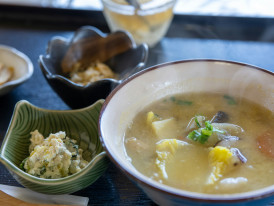
An image of traditional Japan miso soup. Photo by Kouji Tsuru Unsplash
The Locals-Only Spots: My Personal Secrets
If you've made it this far into the night (and this article), you deserve a few genuine local recommendations. These aren't in the guidebooks, and I'm risking my local credibility by sharing them, but here we go:
For travelers seeking Osaka's off-the-beaten-path experiences and away from the city center, these next few spots are my gift to you. They represent the authentic soul of the city that most tourists never discover, hidden in plain sight among the more famous attractions.
![Image of the literary bar, if possible]()
The Literary Bar
In a back alley of Nakazakicho, there's a bar called "Bundan" run by a former literature professor. Every surface is covered with books, and after 2 am, impromptu poetry readings often break out. Order the house special; a cocktail named after whatever book catches the bartender's eye that night.
The Time Capsule
![Vinyl records]()
Near Tengachaya Station, look for a small green door with a brass knob. This bar hasn't changed since the 1970s, and neither has the master who runs it. Vinyl records provide the soundtrack, and the whisky selection rivals places charging three times as much. No menu; just tell him what you like.
The Morning Mission
For the truly dedicated, there's a small shop near Tanimachi 4-chome Station that serves what locals consider the best hangover breakfast in Kansai. They open at 5 am specifically for night workers and determined revelers. Their miso soup is legendary, allegedly made with a secret ingredient that replenishes whatever alcohol depleted.

An empty street in Osaka. Filipe Freitas on Unsplash
The Last Train Home: A Badge of Honor or Defeat?
In Osaka, missing the last train home (usually around 12:30 am) isn't a failure; it's a commitment to the night. Once that train departs, you're in until morning, and that's when some of the most memorable experiences occur.
For visitors, I actually recommend intentionally missing that last train at least once. Stay out until the first trains start running around 5 am. You'll see a secret version of Osaka that most tourists miss entirely.
The Dawn Patrol
There's an unspoken camaraderie among those still out when the morning delivery trucks begin their rounds. Salarymen heading to early shifts nod knowingly at those heading home; no judgment, just mutual recognition of different life rhythms.
The streets get hosed down, steam rises from vents, and convenience stores transition from selling beer to selling coffee. This metamorphosis happens daily, but witnessing it feels like being let in on a secret.
Why Osaka Nightlife Beats Tokyo (A Completely Unbiased Opinion)
![Vibrant Osaka Night]()
As an Osakan, I'm contractually obligated to explain why our nightlife surpasses Tokyo's. Beyond hometown pride, there are legitimate differences:
- Proximity: Osaka packs its entertainment districts densely. You can walk between multiple areas in minutes, not subway rides.
- Price: Your yen stretches much further here. From drinks to cover charges, expect to pay 30-40% less than in Tokyo.
- Personality: Tokyo's nightlife can feel transactional. Osaka feels personal. Bartenders remember you, strangers become drinking buddies, and genuine connections happen nightly.
- Unpretentiousness: We don't do velvet ropes or guest lists. The best spots are often the most unassuming.
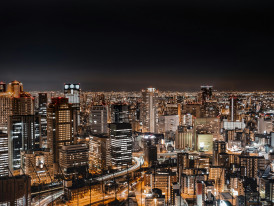
The sky at night in Osaka.Geejay Sabordo on Unsplash
What Makes It the Best Nightlife, According To Me
After decades of exploring nightlife spots across Japan, what brings me back to Osaka's streets night after night isn't the drinking or even the food; it's the feeling that anything might happen.
Tokyo plans, Kyoto preserves, but Osaka improvises. Our nightlife is jazz, not classical music; it rewards spontaneity and creates space for serendipity.
There's a concept we call "nori" in Japanese; it translates roughly to "momentum" or "flow." Osaka nightlife operates on nori. One moment leads naturally to the next, one conversation introduces you to new friends, and suddenly it's dawn and you're eating ramen with people who were strangers hours ago.
How to Experience Osaka nightlife
![Tourists walking the streets at night]()
If you want to experience the city as I do, here are my final pieces of advice:
- Stay flexible: The best nights never follow plans. Let the city guide you.
- Talk to strangers: Osakans love chatting, especially after a drink or two. We're the least reserved Japanese city by far.
- Eat constantly: Food is social glue here. Never turn down an offer to try something.
- Learn a few Osaka-ben phrases: Our dialect signals you're making an effort to connect.
- Follow the crowds of locals: If a place is packed with salarymen or local students, it's good.
- Embrace the side streets: The most authentic nightlife rarely happens on main thoroughfares. The narrow alleys and winding back streets of Central Osaka hide the true gems.
- Don't rush: Unlike Tokyo, where efficiency rules, Osaka rewards those who take their time to discover and explore Osaka properly. Let one experience naturally lead to the next.
The Magic of Japanese Lanterns and Night Markets
![Japanese lanterns at night]()
One element of Osaka's evening scene that deserves special mention is the prevalence of Japanese lanterns throughout the entertainment districts. These aren't just decorative; they're functional guideposts that help navigate the labyrinth of alleys in areas like Shinsekai and Tenma.
The red glow of these lanterns creates an atmosphere that's simultaneously inviting and mysterious. In winter, especially, there's nothing quite like ducking under a lantern-lit doorway to escape the cold, entering a world of warmth and friendliness that feels worlds away from the street outside.
The Seasonal Rhythms of Nightlife
While nightlife here thrives year-round, each season brings distinct experiences. Summer means rooftop bars and riverside drinking, with Japanese lanterns strung overhead. Fall brings special seasonal sake and the perfect weather for bar-hopping. Winter drives everyone indoors to cozy izakayas with steamed windows. Spring sees streets lined with cherry blossoms, creating natural canopies for outdoor parties.
![Street performance at night]()
The Morning After: Closing Thoughts
The real magic of Osaka happens in those small moments between planned activities, the conversation with an elderly bartender who shares his life story, the impromptu street performance you stumble upon, or the food stall owner who insists you try her special recipe.
By morning, as I finally head home with the sunrise warming my back, I'm reminded of why I could never leave this city. There are countless things to do in Osaka during daylight hours, but to truly understand its soul, you need to see it under neon lights, with a drink in hand and new friends by your side.

